Optimal Siting and Sizing of Wayside Energy Storage Systems in a D.C. Railway Line
Abstract
:1. Introduction
- Mobile ESSs, located on board vehicles.
- Wayside ESSs, installed in electrical substations or along the track, which don’t place weight or size constraints and which balance the voltage in the weak points of the network [6].
Novelty of Approach Proposed
2. Methods
2.1. The Train Performance Simulation
- The plan-altimetry characteristics of the line, i.e. the slope of the line with respect to a zero-horizontal line (expressed in ‰), in addition to the radius of curvature of the curves and the length of the tunnels on the analyzed route.
- The electro-mechanical characteristics of rolling stock, in order to simulate various types of trains along the line.
2.2. The Electrical Model of the Traction System
- Electric substation: Figure 2 shows the V-I characteristic and the equivalent circuit adopted for a typical Substation. When the Substation is disconnected (zone 2), at node A is imposed the P = 0 condition. In supply or regeneration status, the node is set with the V = V0 condition (no-load output voltage) or V = Vrec (network recovery voltage) and the equivalent resistance R2 or R1 is introduced, respectively, for the different voltage drop in the inverter and rectifier bridges.
- Vehicles in traction: the node is normally set with the P = constant condition. If the pantograph voltage decreases and the current exceeds the maximum value allowed by the electric drive, the iterative computation to resolve the non-linear equations system is repeated imposing the constraint I = Imax, i.e. constant current absorption. The model follows the V-P characteristic shown in Figure 3. Vmin is the minimum line voltage allowed to contain voltage drops while Vmax is the maximum line voltage allowed for which the system can receive the braking power supplied by the rolling stock.
- Braking vehicles: if the system is receptive, all the power is fed into the traction line, as long as the node voltage, resulting from the solution of the system of equations, allows it. In fact, if the Vmax value is reached, only a portion of the recoverable power is fed into the line. This voltage is a non-linear function of the voltage in the nodes and in the network conductances. The difference between the recoverable power and that actually recovered represents the power dissipated on the braking resistors.
2.3. Economic Model
2.4. Optimization
2.4.1. Problem formulation
2.4.2. PSO Algorithm
3. Results
3.1. Case Study
- Without possibility of recovering the braking energy by trains running on the railway line and without ESSs along the line.
- With the possibility of recovering the braking energy by trains and without ESS along the line.
- With the possibility of recovering the braking energy and with ESS installed along the line.
- Fun: objective function, specified as a function handle or function name (in this case the NPV calculation explained in Section 2.3).
- Nvars: number of variables, specified as a positive integer (for the proposed model it is equal to 3). The solver passes row vectors of length “nvars” to “fun”.
- Lb: lower bounds, specified as a real vector or array of doubles.
- Ub: upper bounds, specified as a real vector or array of doubles.
- Options: options for “particleswarm” function, in particular the swarm size and the maximum number of iterations.
3.1.1. Topological Characteristics of Railway Line
3.1.2. Electrical Characteristics
3.1.3. Rolling Stock Characteristics
3.1.4. Timetable
- During the “peak” period, lasting 2 hours, every 7 minutes a train departs from the departure and arrival stations.
- During the “soft” period, also lasting 2 hours, every 30 minutes a train departs from the departure and arrival stations.
3.2. Numerical Results
- NPV: 391,577.59 €
- Payback period: 2.844 years
- ESS’s position: 55 km
- Nominal power: 0.400 MW
- Nominal energy: 0.200 MWh
- NPV: 383,451.71 €
- Payback period: 3.6648 years
- ESSs’ position: 6 km, 55 km
- Nominal power: 0.100 MW, 0.400 MW
- Nominal energy: 0.100 MWh, 0.200 MWh
4. Discussion
5. Conclusions
Author Contributions
Funding
Conflicts of Interest
Abbreviations
| Capital cost of the ESS (€) | |
| n | Generic year during the life of the ESS (-) |
| N | Useful life (in years) of the ESS (-) |
| Cash flow of the year “n” (€) | |
| Income of the year “n” (€) | |
| Expenses of the year “n” (€) | |
| Total days of use of the ESS within one year (-) | |
| Number of peak periods per day (-) | |
| Number of soft periods per day (-) | |
| Total energy withdrawn from the primary network, without ESSs in the track, in the year “n” (kWh) | |
| Total energy withdrawn from the primary network, with ESSs in the track, in the year “n” (kWh) | |
| Total energy withdrawn from the primary network, without ESSs in the track, in one working day (kWh) | |
| Total energy withdrawn from the primary network, without ESSs in the track, in one working day (kWh) | |
| Total energy withdrawn from the primary network during the peak period, without ESSs in the track (kWh) | |
| Total energy withdrawn from the primary network during the soft period, without ESSs in the track (kWh) | |
| Total energy withdrawn from the primary network during the peak period, with ESSs in the track (kWh) | |
| Total energy withdrawn from the primary network during the soft period, with ESSs in the track (kWh) | |
| Cost of electricity coefficient (€/kWh) | |
| Fixed costs of the ESS (€/kW) | |
| PBP | Payback Period (in years) of the ESS (-) |
| Nominal power of the ESS (MW) | |
| Variable costs of the ESS (€/kWh) | |
| Total energy supplied by the ESS in a working day (kWh) | |
| Energy supplied by the ESS during the peak period (kWh) | |
| Energy supplied by the ESS during the soft period (kWh) | |
| Average value of the battery charging efficiency (-) | |
| Specific cost of battery power (€/kW) | |
| Specific cost of battery energy (€/kWh) | |
| Nominal energy of the ESS (MWh) | |
| Future value of replacement cost (€) | |
| Future value of the battery (assumed to be equal to the capital cost of the battery) (€) | |
| Interest rate (-) | |
| Battery replacement period (in years) (-) | |
| Useful life (in years) of the batteries (-) | |
| NPV | Net present value |
| Number of times the battery must be replaced during the life of the ESS (-) |
References
- European Comission. EU Energy, Transport and GHG Emissions Trends to 2050, Reference Scenario 2016. Available online: http://ec.europa.eu/energy (accessed on 26 November 2020).
- Aguado, J.A.; Sánchez Racero, A.J.; de la Torre, S. Optimal Operation of Electric Railways with Renewable Energy and Electric Storage Systems. IEEE Trans. Smart Grid 2018, 9, 993–1001. [Google Scholar] [CrossRef]
- Lamedica, R.; Ruvio, A.; Papalini, A.; Spalvieri, C.; Rossetta, I. Train braking impact on energy recovery: The case of the 3 kV d.c. railway line Roma-Napoli via Formia. In Proceedings of the 2019 AEIT International Annual Conference, Florence, Italy, 18–20 September 2019; pp. 1–6. [Google Scholar]
- Su, S.; Tang, T.; Wang, Y. Control of urban rail transit equipped with ground-based supercapacitor for energy saving and reduction of power peak demand. Energies 2016, 9, 1–19. [Google Scholar]
- Lamedica, R.; Ruvio, A.; Galdi, V.; Graber, G.; Sforza, P.; Guidi Buffarini, G.; Spalvieri, C. Application of Battery Auxiliary Substations in 3kV Railway Systems. In Proceedings of the 2015 AEIT International Annual Conference, Naples, Italy, 14–16 October 2015; pp. 1–6. [Google Scholar]
- Gao, Z.; Fang, J.; Zhang, Y.; Jiang, L.; Sun, D.; Guo, W. Evaluation of strategies to reducing traction energy consumption of metro systems using an Optimal Train Control Simulation model. Int. J. Elec. Power 2015, 67, 439–447. [Google Scholar] [CrossRef]
- Kampeerawat, W.; Toseki, T. Integrated design of smart train scheduling, use of onboard energy storage, and traction power management for energy-saving urban railway operation. IEEJ J. Ind. Appl. 2019, 8, 893–903. [Google Scholar] [CrossRef]
- Wu, C.; Lu, S.; Xue, F.; Jiang, L.; Chen, M. Optimal Sizing of Onboard Energy Storage Devices for Electrified Railway Systems. IEEE Trans. Transport. Electrific. 2020, 6, 1301–1311. [Google Scholar] [CrossRef]
- Popescu, M.; Bitoleanu, A. A Review of the Energy Efficiency Improvement in DC Railway Systems. Energies 2019, 12, 1092. [Google Scholar] [CrossRef] [Green Version]
- Meinert, M. New mobile energy storage system for rolling stock. In Proceedings of the 2009 European Conference on Power Electronics and Applications, Barcelona, Spain, 8–10 September 2009; pp. 1–10. [Google Scholar]
- Kampeerawat, W.; Toseki, T. Efficient urban railway design integrating train scheduling, wayside energy storage, and traction power management. IEEJ J. Ind. Appl. 2019, 8, 915–925. [Google Scholar] [CrossRef]
- Barsali, S.; Bechini, A.; Giglioli, R.; Poli, D. Storage in electrified transport systems. In Proceedings of the 2012 IEEE International Energy Conference and Exhibition, Florence, Italy, 9–12 September 2012; pp. 1003–1008. [Google Scholar]
- Hanmin, L.; Gildong, K.; Changmu, L.; Euijin, J. Field tests of DC 1500 V stationary energy storage system. Int. J. Railway 2012, 5, 124–128. [Google Scholar]
- Ratniyomchai, T.; Kulworawanichpong, T. A Demonstration Project for Installation of Battery Energy Storage System in Mass Rapid Transit. Energy Procedia 2017, 138, 93–98. [Google Scholar] [CrossRef]
- Barrero, R.; Tackoen, X.; Van Mierlo, J. Stationary or onboard energy storage systems for energy consumption reduction in a metro network. Proc. Inst. Mech. Eng. F J. Rail Rapid Transit 2010, 224, 207–225. [Google Scholar] [CrossRef]
- Gee, A.M.; Dunn, R.W. Analysis of trackside flywheel energy storage in light rail systems. IEEE Trans. Veh. Technol. 2015, 64, 3858–3869. [Google Scholar] [CrossRef]
- Lee, H.; Song, J.; Jang, G.; Kim, G.; Lee, H.; Lee, C. Capacity optimization of the supercapacitor energy storages on DC railway system using a railway powerflow algorithm. Int. J. Innov. Comput. I. 2011, 7, 2739–2753. [Google Scholar]
- Ratniyomchai, T.; Hillmansen, S.; Tricoli, P. Optimal capacity and positioning of stationary supercapacitors for light rail vehicle systems. In Proceedings of the 2014 International Symposium on Power Electronics, Electrical Drives, Automation and Motion, Ischia, Italy, 18–20 June 2014; pp. 807–812. [Google Scholar]
- Battistelli, L.; Ciccarelli, F.; Lauria, D.; Proto, D. Optimal design of DC electrified railway stationary storage system. In Proceedings of the 2009 International Conference on Clean Electrical Power, Capri, Italy, 9–11 June 2009; pp. 739–745. [Google Scholar]
- Ratniyomchai, T.; Hillmansen, S.; Tricoli, P. Energy loss minimisation by optimal design of stationary supercapacitors for light railways. In Proceedings of the 2015 International Conference on Clean Electrical Power, Taormina, Italy, 16–18 June 2015; pp. 511–517. [Google Scholar]
- Calderaro, V.; Galdi, V.; Graber, G.; Piccolo, A. Optimal siting and sizing of stationary supercapacitors in a metro network using PSO. In Proceedings of the 2015 IEEE International Conference on Industrial Technology, Seville, Spain, 17–19 March 2015; pp. 1–6. [Google Scholar]
- Xia, H.; Chen, H.; Yang, Z.; Lin, F.; Wang, B. Optimal Energy Management, Location and Size for Stationary Energy Storage System in a Metro Line Based on Genetic Algorithm. Energies 2015, 8, 11618–11640. [Google Scholar] [CrossRef]
- Graber, G.; Calderaro, V.; Galdi, V.; Piccolo, A.; Lamedica, R.; Ruvio, A. Techno-economic Sizing of Auxiliary-Battery-Based Substations in DC Railway Systems. IEEE T. Transp. Electr. 2018, 4, 616–625. [Google Scholar] [CrossRef]
- De la Torre, S.; Sanchez-Racero, A.J.; Aguado, J.A.; Reyes, M.; Martianez, O. Optimal Sizing of Energy Storage for Regenerative Braking in Electric Railway Systems. IEEE Trans. Power Syst. 2015, 30, 1492–1500. [Google Scholar] [CrossRef]
- Wang, B.; Yang, Z.; Lin, F.; Zhao, W. An improved genetic algorithm for optimal stationary energy storage system locating and sizing. Energies 2014, 7, 6434–6458. [Google Scholar] [CrossRef] [Green Version]
- Li, Y.; Wang, J.; Gu, C.; Liu, J.; Li, Z. Investment optimization of grid-scale energy storage for supporting different wind power utilization levels. J. Mod. Power Syst. Clean Energy 2019, 7, 1721–1734. [Google Scholar] [CrossRef] [Green Version]
- Yuan, Z.; Wang, W.; Wang, H.; Yildizbasi, A. A new methodology for optimal location and sizing of battery energy storage system in distribution networks for loss reduction. J. Energy Storage 2020, 29, 101368. [Google Scholar] [CrossRef]
- Miao, D.; Hossain, S. Improved gray wolf optimization algorithm for solving placement and sizing of electrical energy storage system in micro-grids. ISA Trans. 2020, 102, 376–387. [Google Scholar] [CrossRef]
- Kerdphol, T.; Fuji, K.; Mitani, Y.; Watanabe, M.; Qudaih, Y. Optimization of a battery energy storage system using particle swarm optimization for stand-alone microgrids. Int. J. Elec. Power. 2016, 81, 32–39. [Google Scholar] [CrossRef]
- Yoshida, Y.; Figueroa, H.P.; Dougal, R.A. Use of Time Series Load Data to Size Energy Storage Systems. In Proceedings of the 2018 IEEE Green Energy and Smart Systems Conference, Long Beach, CA, USA, 29–30 October 2018; pp. 1–6. [Google Scholar]
- Pandey, A.K.; Kirmani, S. Optimal location and sizing of hybrid system by analytical crow search optimization algorithm. Int. Trans. Electr. Energy Syst. 2020, 30, e12327. [Google Scholar] [CrossRef]
- Ruiyang, J.; Jie, S.; Jie, L.; Wei, L.; Chao, L. Location and Capacity Optimization of Distributed Energy Storage System in Peak-Shaving. Energies 2020, 13, 513. [Google Scholar]
- Rajamand, S. Loss cost reduction and power quality improvement with applying robust optimization algorithm for optimum energy storage system placement and capacitor bank allocation. Int. J. Energy Res. 2020, 44, 11973–11984. [Google Scholar] [CrossRef]
- Lata, P.; Vadhera, S. TLBO-based approach to optimally place and sizing of energy storage system for reliability enhancement of radial distribution system. Int. Trans. Electr. Energ. Syst. 2020, 30, e12334. [Google Scholar] [CrossRef]
- Davis, E. Solving MINLP containing noisy variables and black-box functions using Branch-and-Bound. Comput. Aided Chem. Eng. 2006, 21, 633–638. [Google Scholar]
- Calderaro, V.; Galdi, V.; Graber, G.; Piccolo, A. Deterministic vs. Heuristic Algorithms for Eco-Driving Application in Metro Network. In Proceedings of the 2015 International Conference on Electrical Systems for Aircraft, Railway, Ship Propulsion and Road Vehicles, Aachen, Germany, 3–5 March 2015; pp. 1–6. [Google Scholar]
- Capasso, A.; Lamedica, R.; Ruvio, A.; Giannini, G. Eco-friendly urban transport systems. Comparison between energy demands of the trolleybus and tram systems. Ing. Ferrov. 2014, 69, 329–347. [Google Scholar]
- Capasso, A.; Lamedica, R.; Ruvio, A.; Ceraolo, M.; Lutzemberger, G. Modelling and simulation of electric urban transportation systems with energy storage. In Proceedings of the 2016 IEEE 16th International Conference on Environment and Electrical Engineering, Florence, Italy, 7–10 June 2016; pp. 1–5. [Google Scholar]
- Lamedica, R.; Gatta, F.M.; Geri, A.; Sangiovanni, S.; Ruvio, A. A software validation for dc electrified transportation system: A tram line of Rome. In Proceedings of the 2018 IEEE International Conference on Environment and Electrical Engineering and 2018 IEEE Industrial and Commercial Power Systems Europe, Palermo, Italy, 12–15 June 2018; pp. 1–6. [Google Scholar]
- Poonpun, P.; Jewell, W.T. Analysis of the cost per kilowatt hour to store electricity. IEEE Trans. Energy Convers. 2008, 23, 529–534. [Google Scholar] [CrossRef]
- Del Valle, Y.; Venayagamoorthy, G.K.; Mohagheghi, S.; Hernandez, J.C.; Harley, R.G. Particle Swarm Optimization: Basic Concepts, Variants and Applications in Power Systems. IEEE T. Evolut. Comput. 2008, 12, 171–195. [Google Scholar] [CrossRef]
- Dindar, S.; Kaewunruen, S.; An, M. Identification of appropriate risk analysis techniques for railway turnout systems. J. Risk Res. 2018, 21, 974–995. [Google Scholar] [CrossRef]
- Alawad, H.; Kaewunruen, S.; An, M. Learning from Accidents: Machine Learning for Safety at Railway Stations. IEEE Access. 2020, 8, 633–648. [Google Scholar] [CrossRef]
- Kaewunruen, S.; Bin Osman, M.H.; Wong, H.C.E. Risk-based maintenance planning for rail fastening systems. ASCE ASME J. Risk Uncertain. Eng. Syst. A Civ. Eng. 2019, 5, 04019007. [Google Scholar] [CrossRef] [Green Version]
- Kampczyk, A. Measurement of the Geometric Center of a Turnout for the Safety of Railway Infrastructure Using MMS and Total Station. Sensors 2020, 20, 4467. [Google Scholar] [CrossRef] [PubMed]
- Wang, H.; Chang, L.; Markine, V.L. Structural Health Monitoring of Railway Transition Zones Using Satellite Radar Data. Sensors 2018, 18, 413. [Google Scholar] [CrossRef] [PubMed] [Green Version]
- Guo, Y.; Zhao, C.; Markine, V.L.; Jing, G.; Zhai, W. Calibration for discrete element modelling of railway ballast: A review. Transp. Geotech. 2020, 23, 100341. [Google Scholar] [CrossRef]
- Dindar, S.; Kaewunruen, S.; An, M. Rail accident analysis using large-scale investigations of train derailments on switches and crossings: Comparing the performances of a novel stochastic mathematical prediction and various assumptions. Eng. Fail. Anal. 2019, 103, 203–216. [Google Scholar] [CrossRef]
- Ye, Y.; Shi, D.; Poveda-Reyes, S.; Hecht, M. Quantification of the influence of rolling stock failures on track deterioration. J. Zhejiang Univ. Sci. A 2020, 21, 783–798. [Google Scholar] [CrossRef]
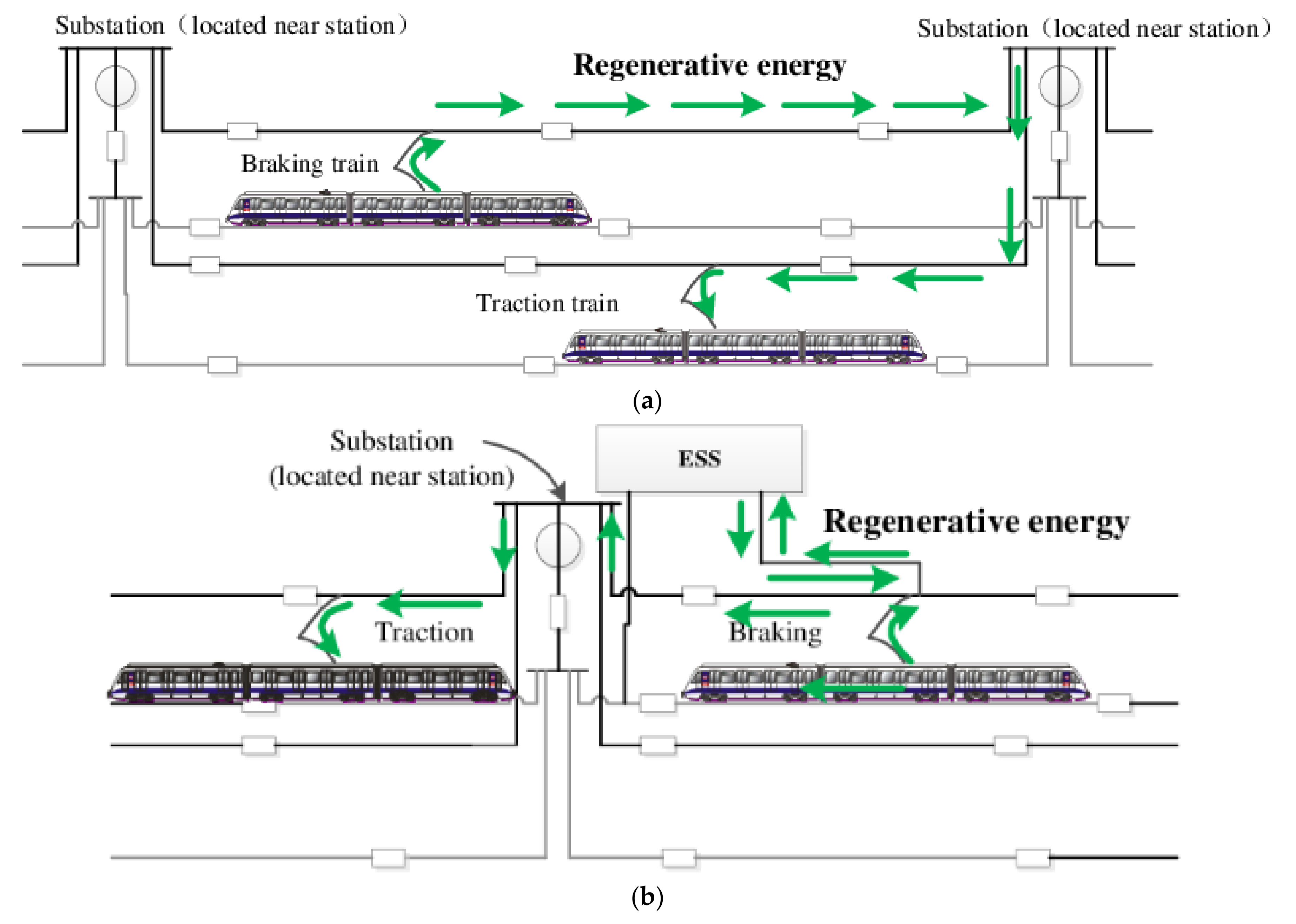
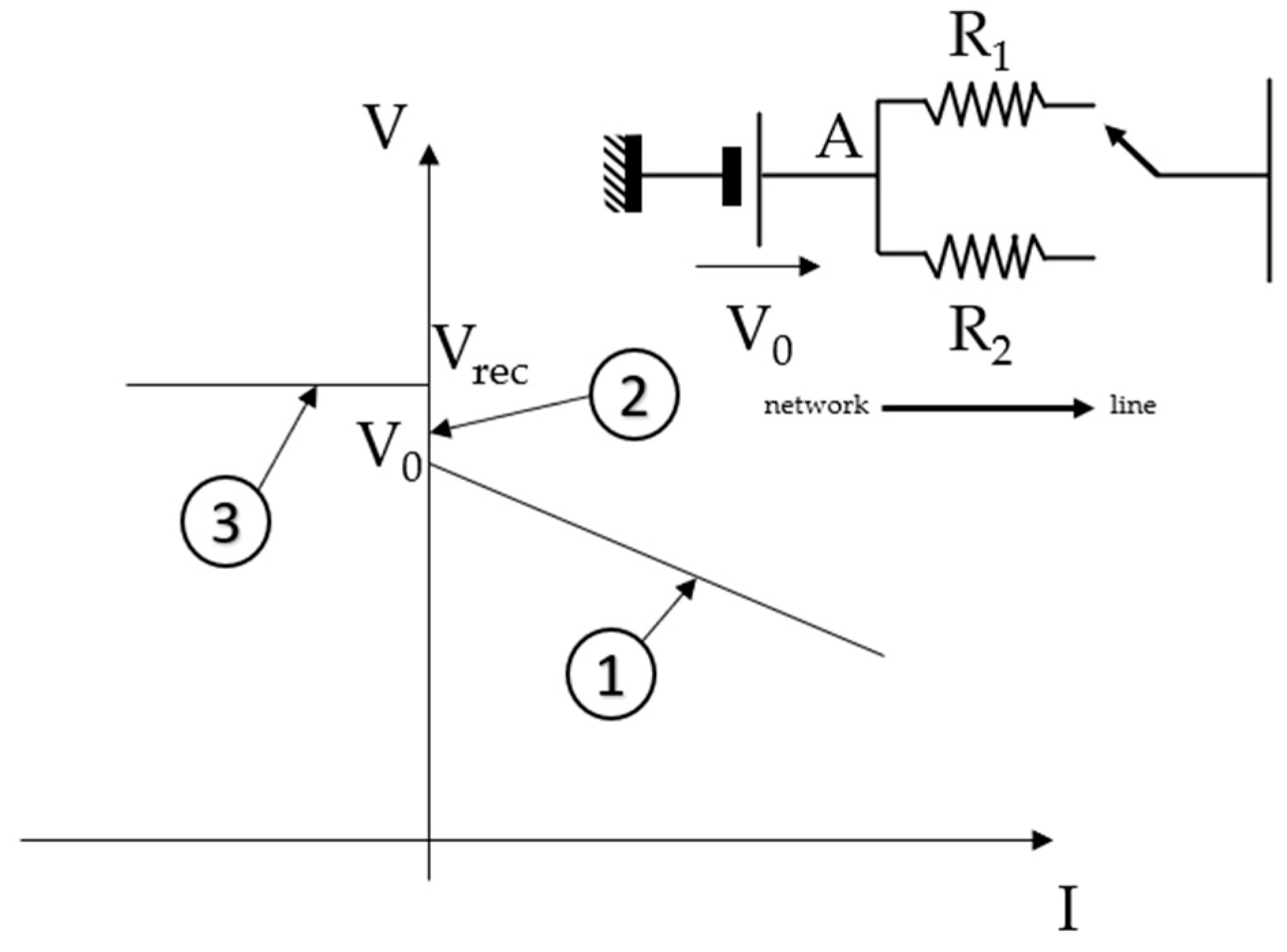

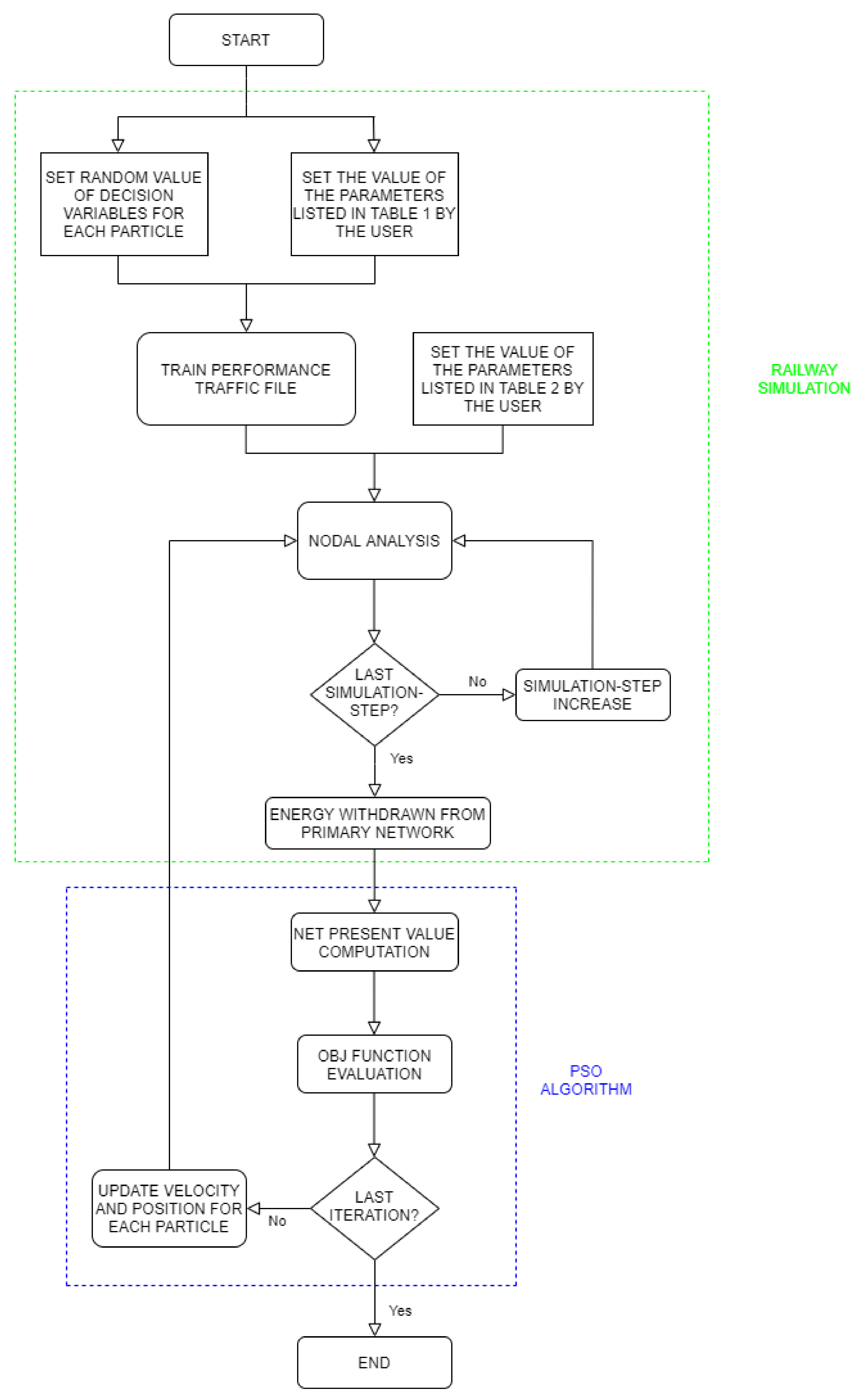

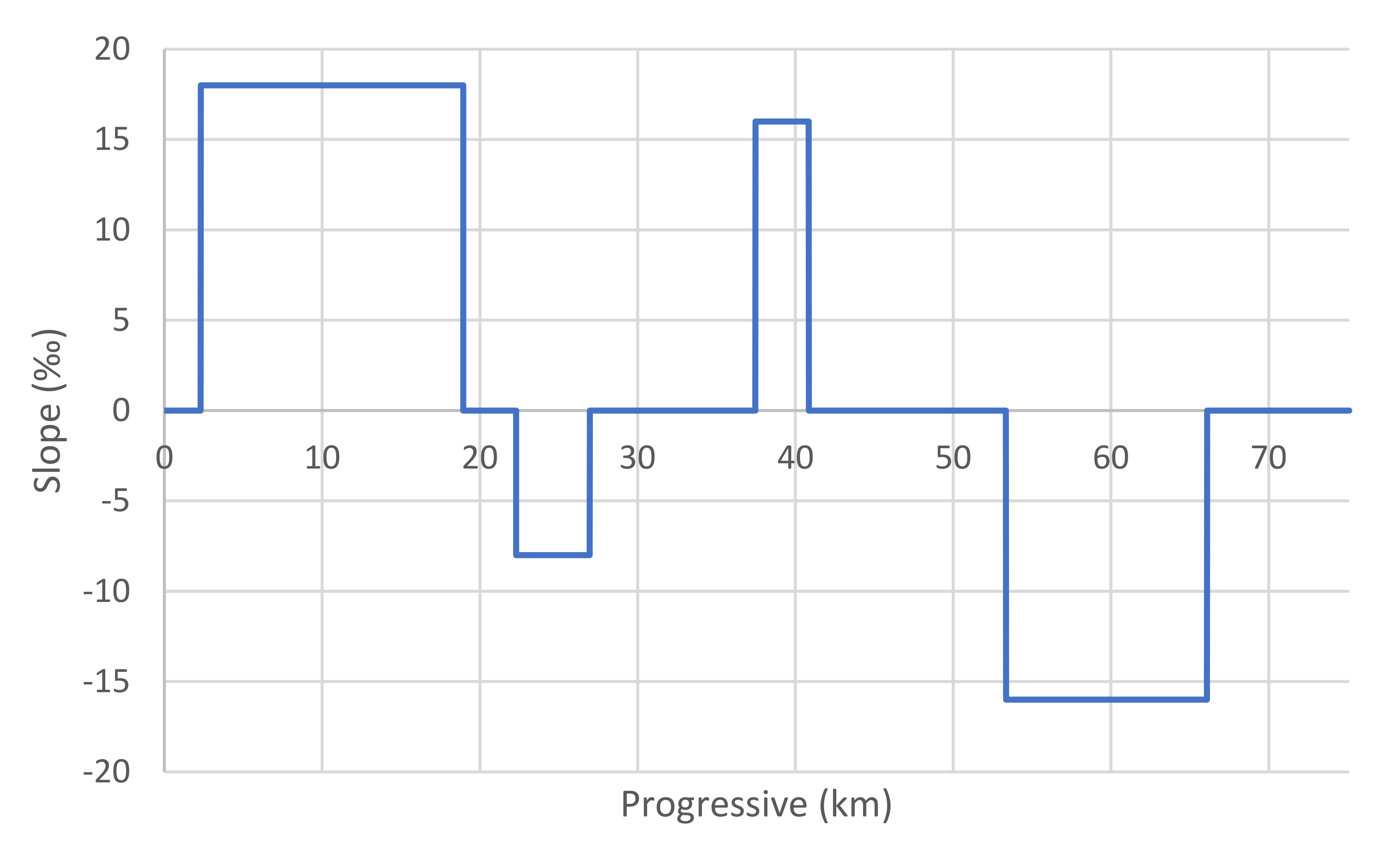
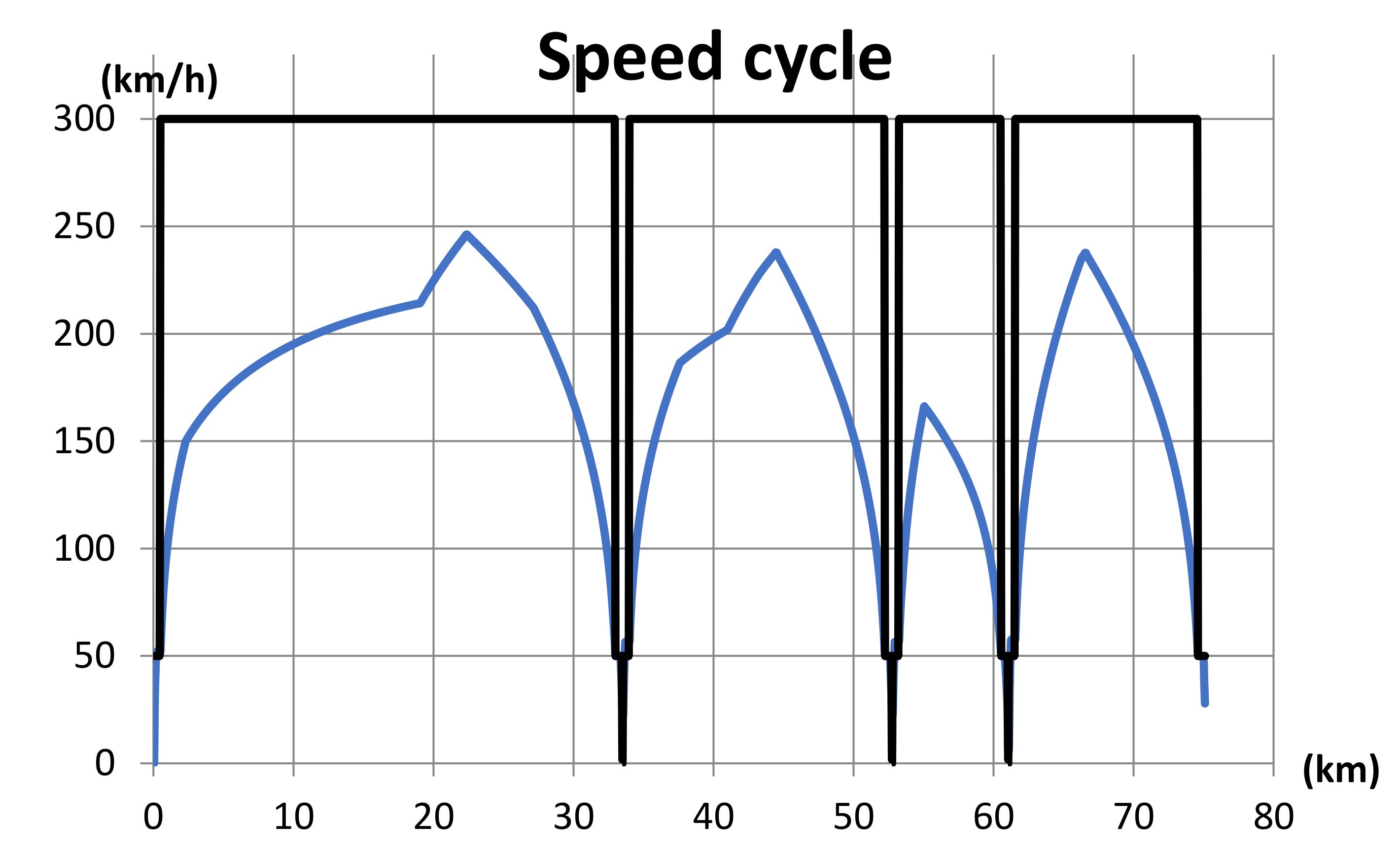
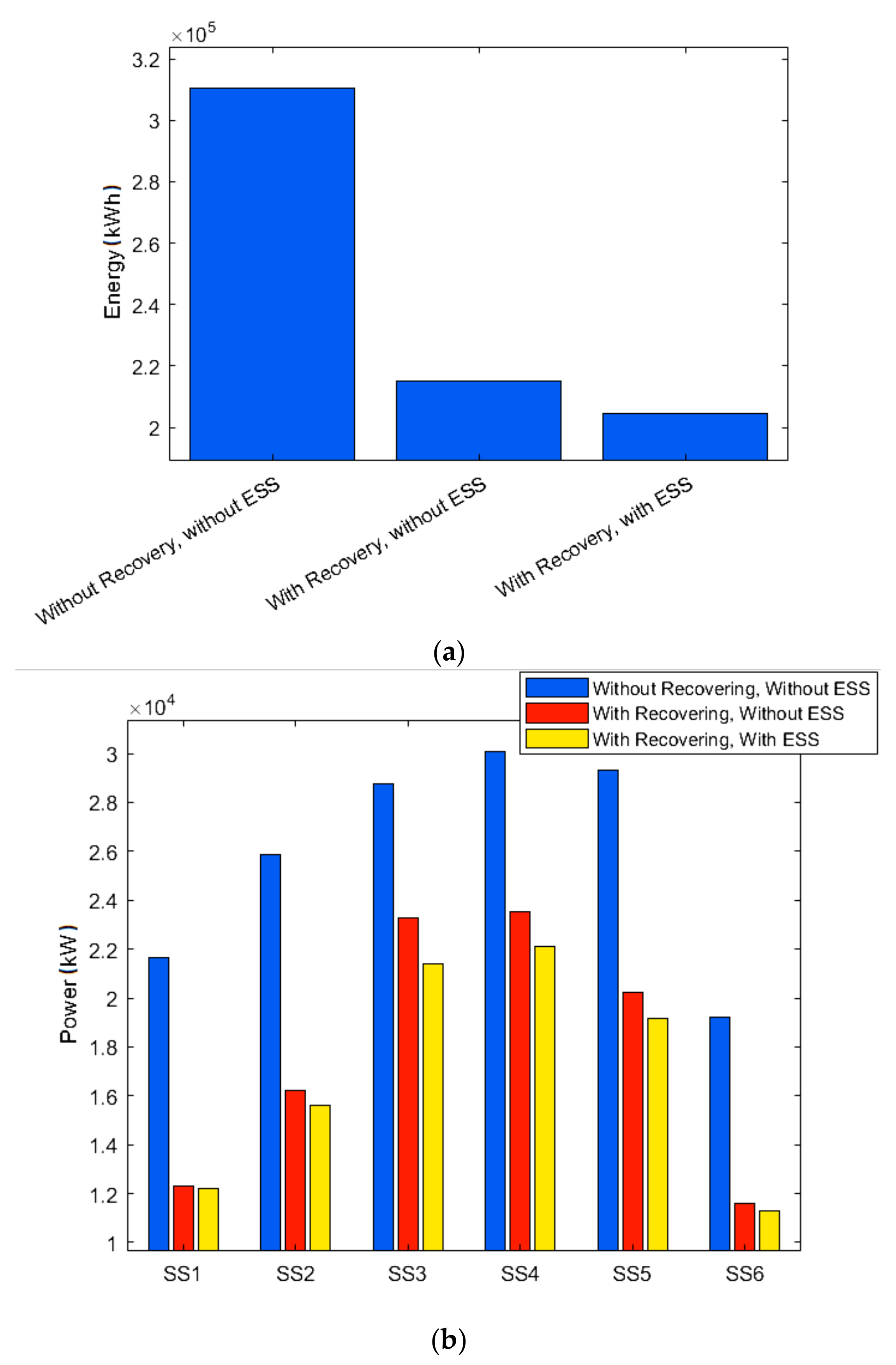
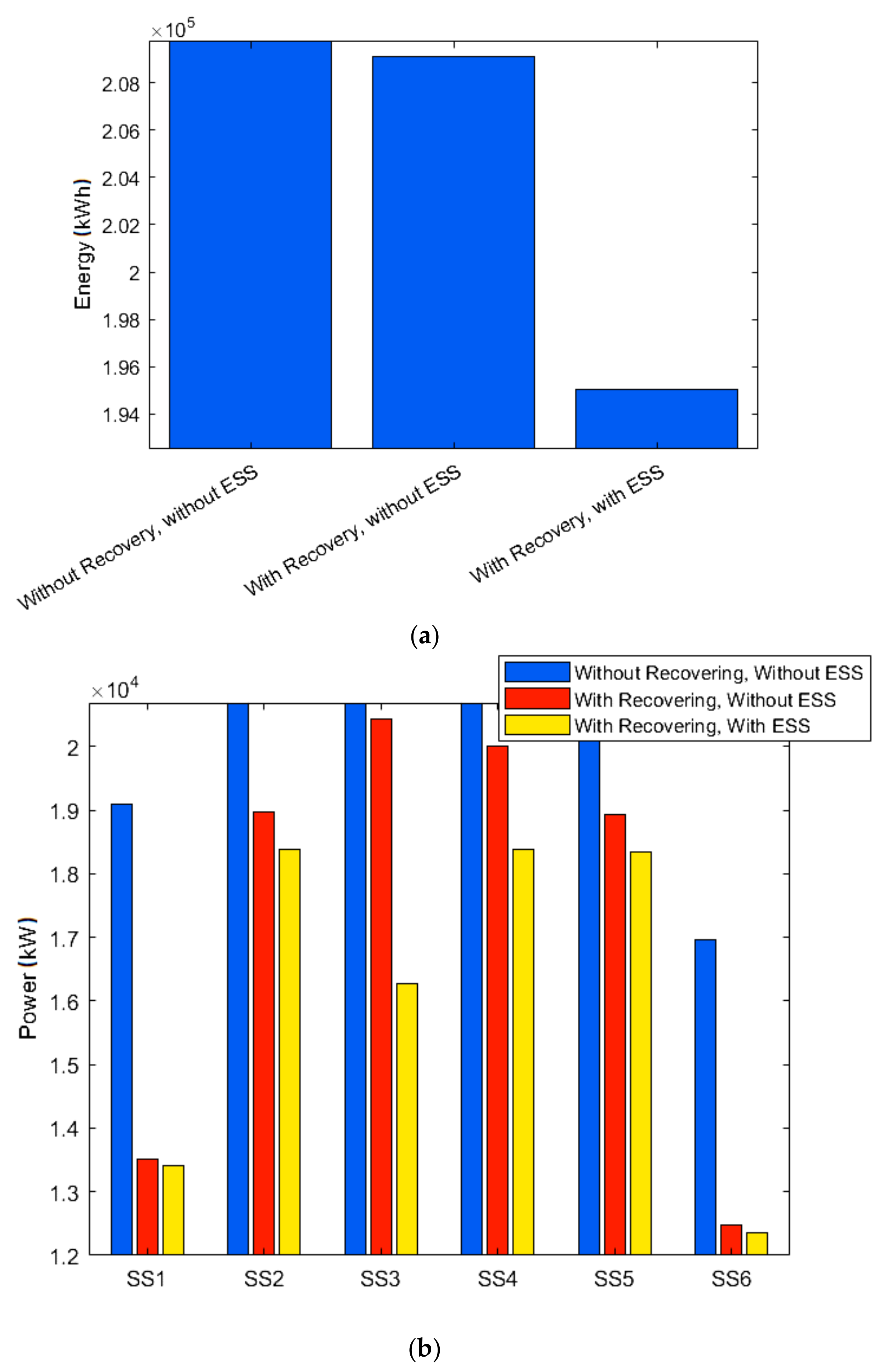
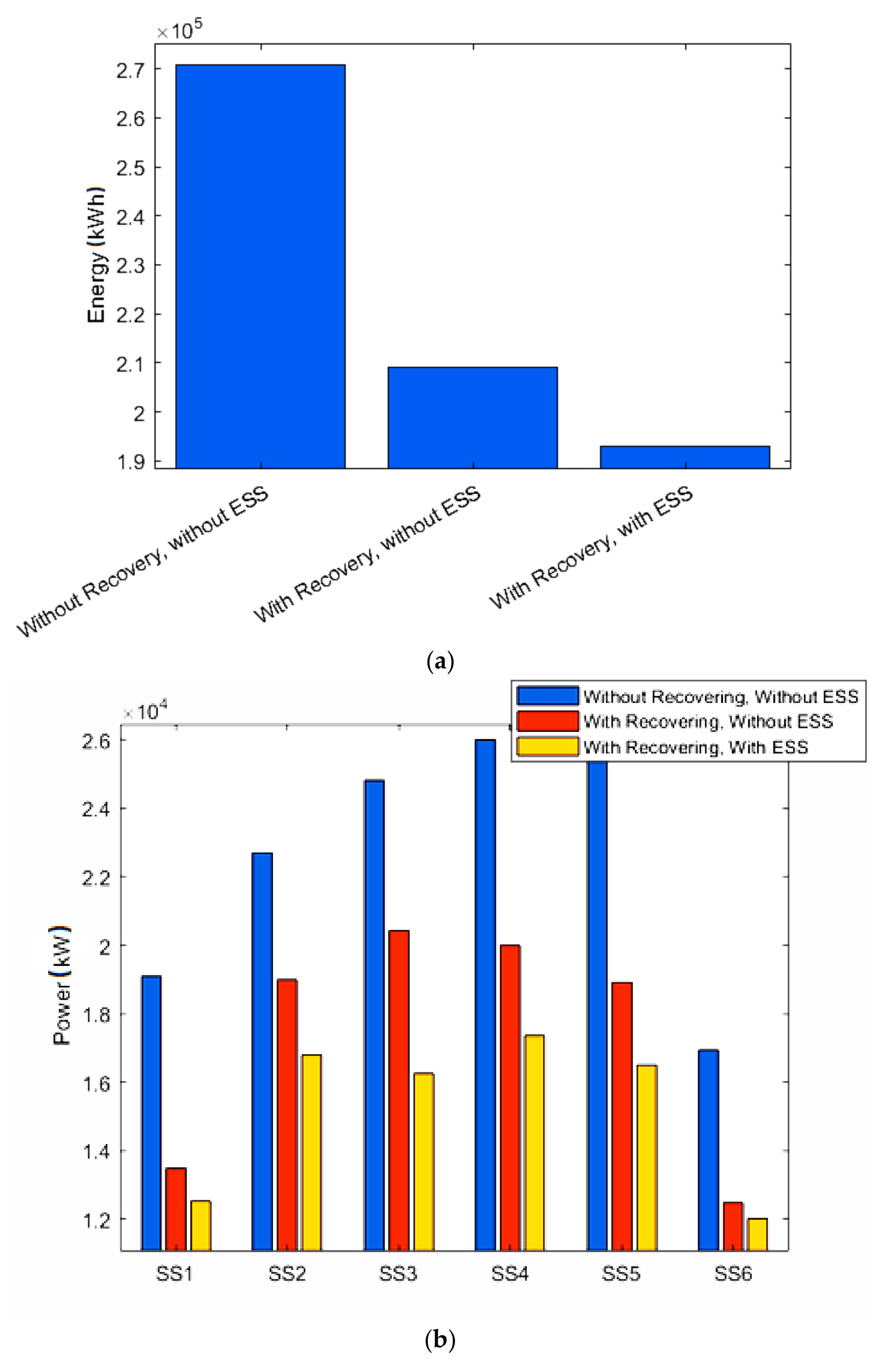
| Characteristics of the Route (Inputs) | Characteristics of the Vehicle (Inputs) | Values Every 15 Seconds (Outputs) |
|---|---|---|
| Progressive | Aerodynamic resistance | Pantograph power |
| Slopes Curves Tunnels Speed limits | Traction force Braking force Weight | Distance |
| Electrical Inputs | Outputs |
|---|---|
| Number and kilometric point of substations | Instantaneous powers required to substations |
| Number and type of transformer-rectifier units | Voltage at the vehicle pantographs, at substation bars and at parallel points |
| Catenary feature | Line minimum instantaneous voltages |
| Line rated, minimum and maximum voltage | Current on substation feeders and in traction circuit branches |
| Traffic Input | Recovered energy on line |
| Train performance traffic file | Power losses in traction circuit |
| Recovered energy in the network Energy storage operating profile |
| Station Name | Progressive (km) |
|---|---|
| Departure station | 0 |
| Intermediate station #1 | 33.5 |
| Intermediate station #2 | 52.75 |
| Intermediate station #3 | 61.05 |
| Arrival station | 75.1 |
| Tunnel Name | Length (km) | From (km) | To (km) |
|---|---|---|---|
| Tunnel #1 | 5 | 43.3 | 48.3 |
| Tunnel #2 | 1.5 | 55.2 | 56.7 |
| Substation Name | Conversion Units | Nominal Power (MW) | Progressive (km) |
|---|---|---|---|
| Electric substation #1 | 2 | 5.4 | 1 |
| Electric substation #2 | 2 | 5.4 | 16 |
| Electric substation #3 | 2 | 5.4 | 30 |
| Electric substation #4 | 2 | 5.4 | 45 |
| Electric substation #5 | 2 | 5.4 | 60 |
| Electric substation #6 | 2 | 5.4 | 73 |
| Parameter | Value | |
|---|---|---|
| Loaded weight | 500 | t |
| Rotating mass coefficient | 0.05 | |
| Motor efficiency | 0.85 | |
| Auxiliaries power | 400 | kW |
| Full speed | 360 | km/h |
| Maximum traction effort | 370 | kN |
| Maximum deceleration | 0.6 | m/s2 |
| From (hh:mm) | To (hh:mm) | Band |
|---|---|---|
| 07:00 | 09:00 | Peak |
| 09:00 | 11:00 | Soft |
| 11:00 | 13:00 | Soft |
| 13:00 | 15:00 | Peak |
| 15:00 | 17:00 | Soft |
| 17:00 | 19:00 | Peak |
| 19:00 | 21:00 | Soft |
| 21:00 | 23:00 | Soft |
| Parameters | Values | Unit |
|---|---|---|
| Cp | 120 | €/kW |
| CE | 440 | €/kWh |
| Cf | 7.2 | €/kW |
| Cv | 0.0011 | €/kWh |
| Cch | 0.015 | €/kWh |
| N | 20 | #years |
| ɳCH | 0.90 | - |
| Variables of Decision | Lower Bound | Upper Bound |
|---|---|---|
| Position (km) | 0 | 75.1 |
| Nominal power (MW) | 0.1 | 1 |
| Nominal energy (MWh) | 0.1 | 1 |
Publisher’s Note: MDPI stays neutral with regard to jurisdictional claims in published maps and institutional affiliations. |
© 2020 by the authors. Licensee MDPI, Basel, Switzerland. This article is an open access article distributed under the terms and conditions of the Creative Commons Attribution (CC BY) license (http://creativecommons.org/licenses/by/4.0/).
Share and Cite
Lamedica, R.; Ruvio, A.; Palagi, L.; Mortelliti, N. Optimal Siting and Sizing of Wayside Energy Storage Systems in a D.C. Railway Line. Energies 2020, 13, 6271. https://doi.org/10.3390/en13236271
Lamedica R, Ruvio A, Palagi L, Mortelliti N. Optimal Siting and Sizing of Wayside Energy Storage Systems in a D.C. Railway Line. Energies. 2020; 13(23):6271. https://doi.org/10.3390/en13236271
Chicago/Turabian StyleLamedica, Regina, Alessandro Ruvio, Laura Palagi, and Nicola Mortelliti. 2020. "Optimal Siting and Sizing of Wayside Energy Storage Systems in a D.C. Railway Line" Energies 13, no. 23: 6271. https://doi.org/10.3390/en13236271








